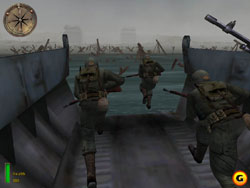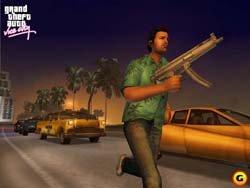

Overview |
Picking a Topic |
Tech Decisions | Design Decisions
Usability Testing |
What Went Right |
What Went Wrong | Conclusions

Picking a Topic
According to my chief advisor, Professor Chris Jackson, the most important
part of the thesis project in the Computer Graphics Design program is to
pick subject matter that is genuinely exciting and appealing to the author.
Although breaking new ground in the field is important, exploring a
technology or topic that is totally unfamiliar to the author is breaking new
ground in its own right. I agree with this philosophy. Like all academic
endeavors, the main goal of this thesis project should be to learn.
Game development is a significant segment of the Computer Graphics Design
industry that I have always wanted to explore. Although I have had a bit of
exposure to basic game development during my graduate studies, it is usually
limited to small proof-of-concept exercises that are created in Macromedia
Director or Flash. Although these projects are useful and fun, I wanted to
explore professional grade game development engines for real-time 3D.
I have always had an interest in world history and I took a particular
interest in ancient Greek and Roman civilization, art and literature during
my undergraduate studies. After spending a year in Italy in 1992-1993 and
having the opportunity to visit Rome and Pompeii, I continued to enjoy
reading and learning about ancient Roman culture.
While exploring thesis topics, I found that there may be a connection
between ancient Rome and game development (as strange as that may sound).
After continuing to explore both topics, I found that there were indeed many
parallels in the role of violence as entertainment in ancient Roman
gladiatorial spectacle and contemporary video games. Although I knew that a
comprehensive study of these parallels was not suited to a thesis that was
to focus on the creation of a visually intensive multimedia project, I still
wanted to explore these concepts.
A Tradition of Violence
The role of violence in Roman conquest and in everyday life has always been
simultaneously fascinating and a bit disturbing to me. Here was a culture
that was responsible for grand achievements in architecture, language, art,
politics and civil engineering that set the stage for a large part of
western civilization as we know it. How could such a culture also be
responsible for brutal imperialism and slavery? How could such a culture
actually enjoy gladiatorial murder as entertainment of the masses?
Here is a sobering thought: maybe humans have
always had a tendency towards violence. Gladiatorial games, warfare and even
genocide may not be isolated aberrations of the human condition. They are
the human condition, or at least a significant part of it.
Millions of years ago, as modern humans were still coming into their own,
the evolutionary tree split. The Neanderthals, a very strong (if not very
bright) primate group was making do with simple tools and clothing.
Cro-Magnons, a slightly less imposing but far more intelligent breed was
about to introduce itself to the Neanderthals. Did these two groups interact
in a peaceful way? Possibly, but the evolutionary record suggests not. Some
suggest that the first encounter between these two groups was similar to
modern encounters between two groups of vastly different technological and
intellectual capabilities. What happened when the Spanish explorers
introduced themselves to the Incas? How about when our American ancestors
introduced themselves to the Native Americans?
For better or worse, I do not think that contemporary humans are any less
bloodthirsty or violence prone than their ancient ancestors. Technology has
provided a buffer to make the human tendency towards violence a bit more
obscured, but I believe it is still there. While a Roman legionnaire may
have had to look into the eyes of his foe as he killed him with his sword,
the contemporary soldier can press a button. The technology may make the
murder more impersonal, but the killing is usually done on a massively
higher scale.
Roman citizens who never saw battle were able to satisfy their lust for
violence by watching Gladiatorial games that were often sponsored by the
emperor himself. Action movies and video games provide a similar role today,
albeit with a smaller body count.
Video Games and Film: The New Gladiatorial Games
I am not ready to dispute whether violence in video games and film
encourages violent behavior in the viewer. There is evidence of mass murder
in the headlines far too frequently that has eerie resemblances to certain
movies or games, so to say that these forms of entertainment have no effect
would be a bit irresponsible. I will make one statement though: people love
this stuff. The games fly off the shelves and people line up around the
block to see the movies. Publishers and producers crank out violence at an
incredible rate, and the public, for better or worse, eats it up.
Violence with Context: Historical
Shooters
Violence in video games has come a long way since controversial favorites
such as “Doom”. As a game player, I am a biased source, but I think it is
fair to say that violent video games today can be divided into those that
simply portray violence for violence’s sake, and those that use violence to
relate a particularly intense story. The advent of what have come to be
called “historical shooters” further proves this point.
I will use a particular game as an example.
“Medal of Honor: Allied Assault” (Publisher: EA Games; Developer: 2015) has
come to define the genre of modern historical shooters. Using World War II
as a starting point, the developers of this game endeavor to put the player
in the boots of a soldier during certain key battles and moments of the
conflict. One of the most memorable experiences occurs when the player lands
on Omaha beach in a Higgins boat on June 6. The game is violent, to be sure,
but the violence serves the narration of the story.

Medal of Honor: Allied Assault. Image
courtesy of gamespot.com
Violence without Context
The other genre of shooter is one that stirs a bit more controversy due to
its explicit and graphic content. These games usually put a violent theme
first and then contrive the story to fit that theme. The theme could be an
occupation, such as a car-jacker/mobster in “Grand Theft Auto: Vice City”, a
professional killer in “Hitman 2: Silent Assasin” or a soldier of fortune in
the appropriately named “Soldier of Fortune”.

Grand theft Auto: Vice City. Image courtesy
of gamespot.com
I find these games hugely addictive and fun
in their own right, but I think it is fair to say that they contain themes
that may not be appropriate for children, and that do little to spark
interest in little else than playing more games of the same genre.
Educational Shooters
This thesis project attempts to create a new game genre of “educational
shooters” by putting the user in a historically accurate setting and
providing an added dimension of exposure to the history contained therin.
Although the primary focus of the game is action and violent battle, players
are also able to interact with objects, props and characters to actively
learn more about historical trivia, architecture and foreign languages.
The ultimate goal of this thesis is to
build the environment and then determine the following:
1)
Does the user find the added
information useful or distracting?
2)
Is the user motivated to find
out more about Roman history?
The definitive answers to these questions
are impossible to answer without being able to gain the opinion of a large
number of users, but an attempt is made to gather an average opinion in
Usability Testing.

<< previous section (Overview) |
main | next section (Technology
Decisions) >>

|

